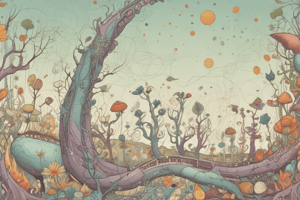Podcast
Questions and Answers
The observable characteristics of an organism are called its ______.
The observable characteristics of an organism are called its ______.
phenotype
The genetic program of an individual organism is called its ______.
The genetic program of an individual organism is called its ______.
genotype
Gregor Mendel is known for his work on the inheritance of traits through ______ plants.
Gregor Mendel is known for his work on the inheritance of traits through ______ plants.
pea
Mendel's controlled experiments produced new organisms known as ______.
Mendel's controlled experiments produced new organisms known as ______.
In a typical monohybrid cross, Mendel worked with ______ pairs of traits.
In a typical monohybrid cross, Mendel worked with ______ pairs of traits.
The seeds obtained from the cross of two parents constitute the first new generation called the ______ Generation.
The seeds obtained from the cross of two parents constitute the first new generation called the ______ Generation.
In the F1 generation, all progeny resembled only one parent and this characteristic is called the ______ trait.
In the F1 generation, all progeny resembled only one parent and this characteristic is called the ______ trait.
After crossing F1 individuals, Mendel obtained the second generation known as the ______ Generation.
After crossing F1 individuals, Mendel obtained the second generation known as the ______ Generation.
Mendel established his 2nd Law: The Rule of ______ Assortment.
Mendel established his 2nd Law: The Rule of ______ Assortment.
The phenotypic ratio in Mendel's dihybrid crosses was ______:3:3:1.
The phenotypic ratio in Mendel's dihybrid crosses was ______:3:3:1.
Mendel's experiments primarily involved the garden ______.
Mendel's experiments primarily involved the garden ______.
T.H. Morgan studied the inheritance patterns of ______ flies.
T.H. Morgan studied the inheritance patterns of ______ flies.
In Drosophila, the wild type flies have ______ eyes.
In Drosophila, the wild type flies have ______ eyes.
The sex chromosomes in fruit flies are ______ for females and XY for males.
The sex chromosomes in fruit flies are ______ for females and XY for males.
In his experiments, all offspring from homozygous red-eyed females and white-eyed males had ______ eyes.
In his experiments, all offspring from homozygous red-eyed females and white-eyed males had ______ eyes.
Mendel's Rule of Segregation states that two alleles for a trait ______ during gamete formation.
Mendel's Rule of Segregation states that two alleles for a trait ______ during gamete formation.
Mendel called the second characteristic that reappeared in low numbers the ______ trait.
Mendel called the second characteristic that reappeared in low numbers the ______ trait.
The ratio of Dominant to Recessive traits in the F2 progeny was ______:1.
The ratio of Dominant to Recessive traits in the F2 progeny was ______:1.
Mendel's experiments aimed to control various factors to avoid ______ in biological experiments.
Mendel's experiments aimed to control various factors to avoid ______ in biological experiments.
The current theory of parental traits becoming mixed was disproved by the reappearance of ______ traits.
The current theory of parental traits becoming mixed was disproved by the reappearance of ______ traits.
The genetic make-up of an organism is determined by its ______.
The genetic make-up of an organism is determined by its ______.
If an organism has two identical alleles for a trait, it is termed ______.
If an organism has two identical alleles for a trait, it is termed ______.
A yellow seed could be either homozygous dominant (YY) or ______ (Yy).
A yellow seed could be either homozygous dominant (YY) or ______ (Yy).
Mendel proposed the ______ of Segregation to explain the outcomes of his experiments.
Mendel proposed the ______ of Segregation to explain the outcomes of his experiments.
This was called CRISSCROSS INHERITANCE (mothers to sons, fathers to daughters) and is related to the inheritance of genes located on sex chromosome or ______.
This was called CRISSCROSS INHERITANCE (mothers to sons, fathers to daughters) and is related to the inheritance of genes located on sex chromosome or ______.
In many plants, a cross between a red flower bearing plant and a white flower bearing plant yields F1 plants with only ______ flowers.
In many plants, a cross between a red flower bearing plant and a white flower bearing plant yields F1 plants with only ______ flowers.
The F2 plants from the previous cross exhibit a red to pink to white ratio of ______:2:1.
The F2 plants from the previous cross exhibit a red to pink to white ratio of ______:2:1.
Instances of INCOMPLETE DOMINANCE involve heterozygous individuals having a phenotype ______ between two homozygous parents.
Instances of INCOMPLETE DOMINANCE involve heterozygous individuals having a phenotype ______ between two homozygous parents.
The phenomenon of mutual expression of both alleles, where neither is dominant over the other, is called ______.
The phenomenon of mutual expression of both alleles, where neither is dominant over the other, is called ______.
In humans, the ABO blood group system involves multiple alleles of the ______ gene.
In humans, the ABO blood group system involves multiple alleles of the ______ gene.
IA and IB alleles are dominant over the ______ allele, which is also known as ii.
IA and IB alleles are dominant over the ______ allele, which is also known as ii.
The rules of blood transfusions are influenced by the presence or absence of sugars called ______.
The rules of blood transfusions are influenced by the presence or absence of sugars called ______.
Flashcards
Phenotype
Phenotype
The observable traits of an organism, resulting from the expression of its genes.
Genotype
Genotype
The genetic makeup of an organism, including all its genes.
Genetics
Genetics
The study of genes and their properties, focusing on how genes relate to an organism's physical characteristics.
Unit Character
Unit Character
Signup and view all the flashcards
Monohybrid Cross
Monohybrid Cross
Signup and view all the flashcards
First Filial Generation (F1)
First Filial Generation (F1)
Signup and view all the flashcards
Dominant Trait
Dominant Trait
Signup and view all the flashcards
Second Filial Generation (F2)
Second Filial Generation (F2)
Signup and view all the flashcards
Recessive Trait
Recessive Trait
Signup and view all the flashcards
F1 Generation
F1 Generation
Signup and view all the flashcards
F2 Generation
F2 Generation
Signup and view all the flashcards
Reciprocal Cross
Reciprocal Cross
Signup and view all the flashcards
Incomplete Dominance
Incomplete Dominance
Signup and view all the flashcards
Incomplete Dominance Cross
Incomplete Dominance Cross
Signup and view all the flashcards
Codominance
Codominance
Signup and view all the flashcards
Codominance Cross
Codominance Cross
Signup and view all the flashcards
Multiple Alleles
Multiple Alleles
Signup and view all the flashcards
ABO Blood Group System
ABO Blood Group System
Signup and view all the flashcards
Antigen
Antigen
Signup and view all the flashcards
Antibody
Antibody
Signup and view all the flashcards
Dihybrid Cross
Dihybrid Cross
Signup and view all the flashcards
Test Cross
Test Cross
Signup and view all the flashcards
Law of Independent Assortment
Law of Independent Assortment
Signup and view all the flashcards
Sex Linkage
Sex Linkage
Signup and view all the flashcards
Fruit Flies (Drosophila melanogaster)
Fruit Flies (Drosophila melanogaster)
Signup and view all the flashcards
Mutant
Mutant
Signup and view all the flashcards
Wild Type
Wild Type
Signup and view all the flashcards
Study Notes
Chapter 5: Genetics
- Genetics studies genes and their properties, focusing on how genes relate to an organism's physical traits.
- Phenotype: Observable characteristics resulting from gene expression.
- Genotype: An organism's complete genetic makeup. Determining characteristics.
- Gregor Mendel, a 19th-century monk, discovered fundamental rules of heredity using pea plants. This is detailed in Chapt V (Slide 2).
- Pea plants were ideal due to easily observable traits and "good" features (Slide 3).
- Mendel used controlled matings (Slide 4) choosing parent plants based on "unit characters" with alternative forms, called "antagonistic pairs" (Slide 5), having clear-cut observable forms (slide 6).
- Mendel’s Experiment resulted in “hybrids” (slides 8 and 9). These hybrids are "Monohybrids" concentrating on one characteristic
- Monohybrid Crosses: Mendel crossed parents with one antagonistic trait pair (Slide 10), creating a generation and first filial generation(F1).
- First generation (F1) progeny typically resemble one trait in the parent and called the Dominant Trait.
- The other observed trait (the recessive trait), reappears in lower numbers in the second generation (F2),(3:1 ratio) (Slide 10)
- This experiment repeated for seven different antagonistic pairs (repeat for each set).
- Principle of Segregation: The concepts discussed will be forming the future of genetics.
- Genotype explanation using Punnet squares (Slide 15) and meiotic distribution of alleles (16 and 17) along with fertilization of gametes.
- Homozygous: Alleles are the same, for a given trait.
- Heterozygous: Alleles are different, for a given trait.
- Test Crosses: Used to determine if an organism with a dominant phenotype is homozygous or heterozygous (Slide 19).
- Dihybrid Crosses: Simultaneous inheritance of two or more traits (Slide 20), showing these genes segregate independently (Slide 21), resulting in a 9:3:3:1 ratio in the second generation (F2).
- Rule of Independent Assortment: The second principle - the different pairs of alleles separate independently of each other during the formation of gametes
Exceptions to Mendelian Genetics
- Incomplete Dominance: Heterozygous offspring exhibit an intermediate phenotype between homozygous parents. Example: Snapdragon flowers (Slide 28-30).
- Codominance: Both alleles are expressed equally in the phenotype. Example: pea seed appearance (spotted/dotted) (Slide 30)
- These patterns are still consistent with the original principle of segregation (Slide 35)
- Sex Linkage: Inheritance of traits linked to sex chromosomes (XX/XY). Example: eye color in fruit flies (Slide 23-27)
Other Concepts in Genetics
- ABO Blood Groups: Multiple alleles of the I gene determine blood type. Exhibits codominance (Slides 32-33)
Studying That Suits You
Use AI to generate personalized quizzes and flashcards to suit your learning preferences.





